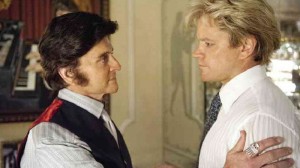
A FILM image released by HBO shows Michael Douglas (left) as Liberace and Matt Damon as Scott Thorson in a scene from “Behind the Candelabra” AP
When we first heard that macho star Michael Douglas had agreed to play gay pianist Liberace in an HBO film bio, we were thrilled at the prospect, because it would clearly be such a huge “stretch” and challenge for the actor.
At the same time, it was such a radical departure for him that we feared that he would flop big time—and end up with thespic egg all over his face!
So, when Steven Soderbergh’s “Liberace—Behind the Candelabra” was released, we made it a point to catch it as soon as possible, to see which way the die would really fall.
Well, Douglas’ fans can relax, because he does so well in the TV movie that it’s become a highlight of his entire career! More to the point, his characterization of Liberace is so spot-on, felt and insightful that his portrayal can serve as a “learning” template and touchstone for all other actors to benefit from.
In particular, Filipino actors can learn a lot from Douglas’ “compleat” performance, because genuine characterizations are rarely seen on the local screen.
The culprit? Our actors’ lazy and smug penchant for “personality” acting rather than portrayals in which the actor “disappears” into the character he’s assigned to play—which is infinitely more difficult to pull off than just coming up with little variations on the actor’s real persona.
Well, Douglas as Liberace will have none of that—nor, for that matter, will Matt Damon in his own superb depiction of Liberace’s longtime lover, Scott Thorson. Another amazingly “total” characterization in “Behind the Candelabra” is turned in by Rob Lowe—as Liberace’s cosmetic surgeon.
All three actors are so different here that, as we watch them create their insightful depictions of the real people they’re playing, we finally understand what acting should really be about: The actor not portraying variations on himself (because, where’s the artistic creativity in that?), but becoming and vivifying his believable and insightful understanding of the character assigned to him, so that he not just looks but also sounds, moves, feels and thinks as much as humanly possible like him.
To be sure, the three “Candelabra” leads aren’t the only actors doing this, the most famously consistent practitioner of character acting being Meryl Streep, who has most impressively “disappeared” into real people as stunningly diverse as Margaret Thatcher and Julia Child.
But, three “totalized” characterizations in one TV movie comprise an unusually rich viewing treat and learning opportunity, so we hope that groups of actors or acting buffs get a copy of the production, watch it together, and discuss it in great detail afterwards.
It’s probably going to be a crushingly humbling group experience, but we can all learn a lot from belatedly eating a slice of thespic humble pie!
We hope that actors watching the production learn in particular about the importance of the performer “forgetting” himself (tough for a self-centered actor to do!) and concentrating completely on his assigned character.
Most actors are too smug or lazy to do the extremely detailed and rigorous work involved, which is why Soderbergh’s “Liberace—Behind the Candelabra” should be a rewarding eye-opener for them!